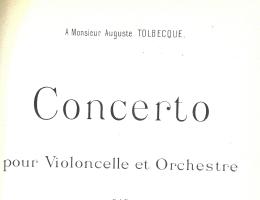Cello Concerto no. 1
Allegro non troppo – Allegretto con moto – Molto Allegro
In spite of the Romantics’ infatuation with the cello, the repertoire inspired by the instrument during this period could not rival that of the violin or the piano. In particular, few composers dedicated a œconcerto to the cello. With the one he composed in 1872, Saint-Saëns endeavoured to fill this gap, offering cellists a work that still features prominently today in their hall of fame. At the same time, he cultivated an “absolute” instrumental genre (with no literary argument), whose decline in favour of “programmatic” pieces he deplored. Dedicated to Auguste Tolbecque, the work was premiered on 19 January 1873 at the Société des Concerts du Conservatoire, conducted by Deldevez. Like Schumann's concerto (of which it also shares the key of A minor), the work comprises three linked movements. The sense of continuity induced by this formal process is reinforced by the cyclical writing of the concerto, whose various themes are recapitulated in the third movement. The passionate flow and feverish expression of the opening phrase, first stated by the cello, favours the blossoming of virtuoso figures (double stops, rapid staccato scales etc.) and alternates with passages of great serenity and even reverie. The second themes stated in the fast movements introduce a gentle, melancholy mood. With its light textures and playful tone, the central Allegretto offers a brief moment of respite, before a return to the drama that forms the transition to the Molto allegro finale.

